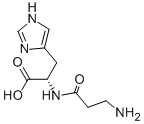CHEMICAL AND PHYSICAL PROPERTIES
| Physical Description | Solid; [Merck Index] White crystalline solid; [Sigma-Aldrich MSDS] |
|---|---|
| Melting Point | 253 - 256 °C |
| Solubility | 384 mg/mL |
| Collision Cross Section | 151 Ų [M+H]+ [CCS Type: DT, Method: single field calibrated with Agilent tune mix (Agilent)] |
| Chemical Classes | Biological Agents -> Amino Acids and Derivatives |
COMPUTED DESCRIPTORS
| Molecular Weight | 226.23 g/mol |
|---|---|
| XLogP3 | -4 |
| Hydrogen Bond Donor Count | 4 |
| Hydrogen Bond Acceptor Count | 5 |
| Rotatable Bond Count | 6 |
| Exact Mass | 226.10659032 g/mol |
| Monoisotopic Mass | 226.10659032 g/mol |
| Topological Polar Surface Area | 121 Ų |
| Heavy Atom Count | 16 |
| Formal Charge | 0 |
| Complexity | 259 |
| Isotope Atom Count | 0 |
| Defined Atom Stereocenter Count | 1 |
| Undefined Atom Stereocenter Count | 0 |
| Defined Bond Stereocenter Count | 0 |
| Undefined Bond Stereocenter Count | 0 |
| Covalently-Bonded Unit Count | 1 |
| Compound Is Canonicalized | Yes |
PRODUCT INTRODUCTION
Description
Carnosine is a dipeptide that is the N-(beta-alanyl) derivative of L-histidine. It has a role as an anticonvulsant, an antioxidant, an antineoplastic agent, a human metabolite, a Daphnia magna metabolite, a mouse metabolite, a neuroprotective agent and a geroprotector. It is a conjugate acid of a carnosinate and a tautomer of a carnosine zwitterion.
